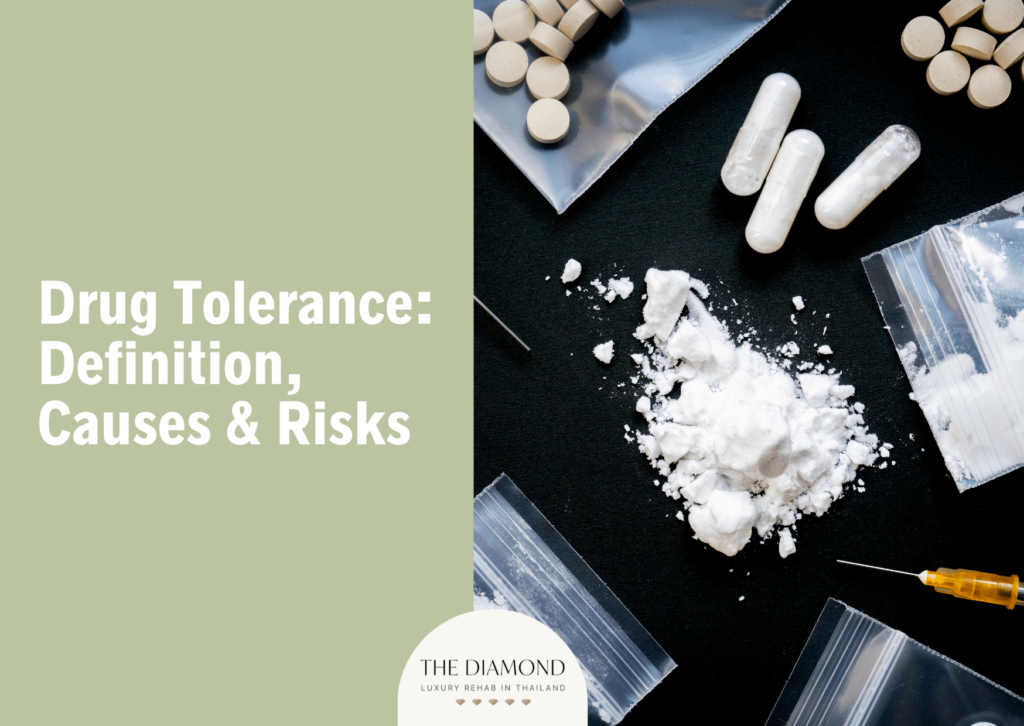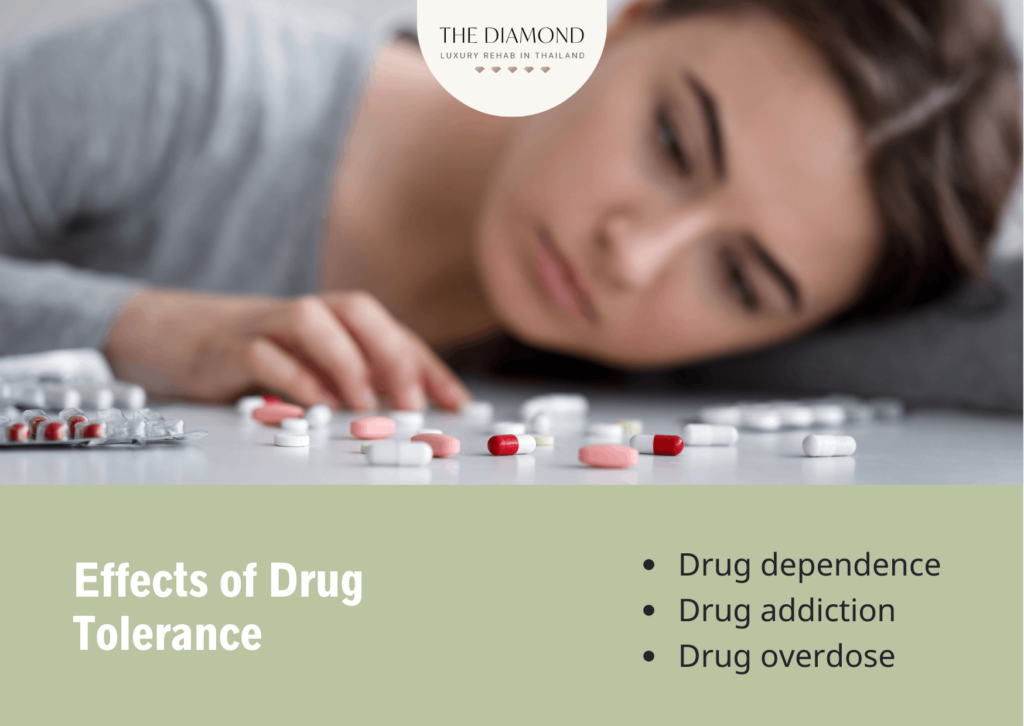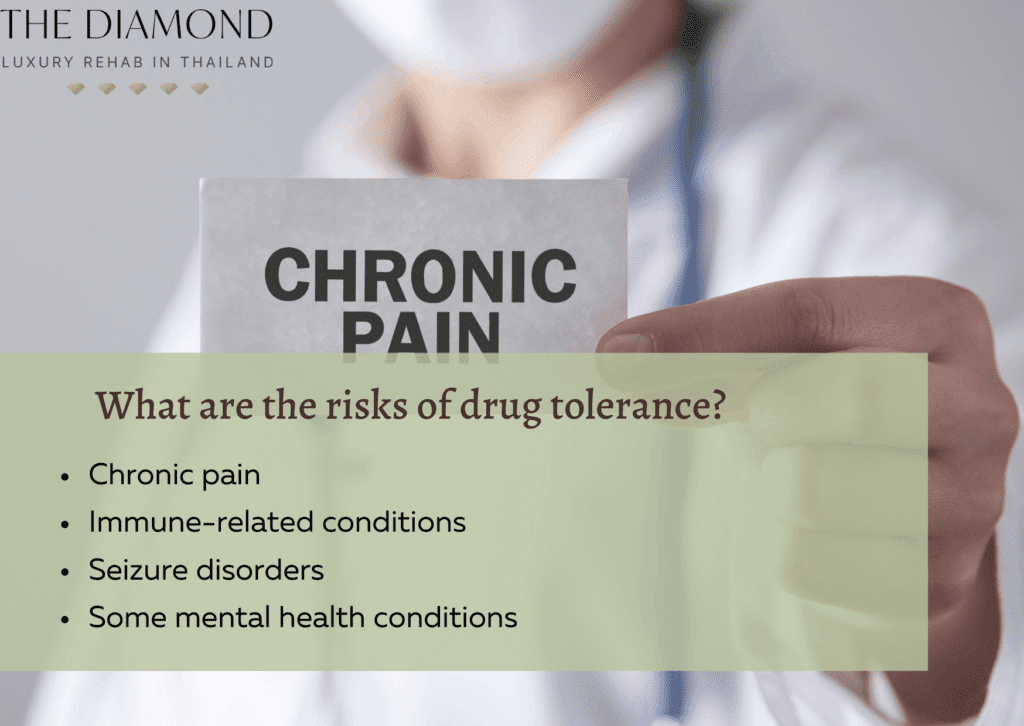Drug Tolerance: definition, causes and risks

Drug tolerance, otherwise known as drug insensitivity, is a reduced reaction or diminished response to a drug. This occurs when a drug is used repeatedly. The body gets adapted to its continual presence.
The causes of drug tolerance are repeated and chronic use of the drugs. Additionally, using larger and larger doses of a substance leads to drug tolerance as well.
Risks of drug tolerance include increased likelihood of overdose, addiction, and dependence on specific classes of drugs, such as opioids.
What is drug tolerance?
Drug tolerance is defined as the diminished response to a drug, alcohol, or other substance over the course of repeated or prolonged exposure. It is a physiological response to a drug that requires greater quantities to offer the same response.
Developing ‘tolerance’ to a certain drug means the body becomes accustomed to the drug in the system at the currently used dosage. It additionally means the drug becomes inefficient in managing a particular health problem. Developing tolerance indicates the body or brain is not responding to the medication like it used to.
This problem happens with both prescription medications and recreational drugs. The enzymes or receptors in the body and brain are less activated by the product. So, the drug doesn’t offer the necessary results.
The higher the tolerance and dependence of a drug, the bigger the doses a person needs to use. Otherwise, the body is incapable of achieving the same results as it did prior to developing tolerance. When dealing with any kind of substance tolerance, it’s important to consult a specialist.
How common is drug tolerance?
Drug tolerance is common among people who take the same drug for a prolonged duration, an article titled, “What to know about drug tolerance” updated in September 2023 from Medical News Today explained. The most abused substances are alcohol, marijuana, hallucinogens, inhalants, and prescription medicines like anxiety pills, stimulants, and pain pills such as opiates.
According to a study by Vadivelu et al., published in the fall 2014 issue of the Ochsner Journal, drug tolerance has been increasing in recent years around the globe. This has made it difficult to find the right pain management strategy.
Opioid use disorder remains at the forefront of epidemic levels in the United States and the globe. About 3 million Americans and 16 million people worldwide are currently suffering or used to suffer from opioid use disorder (OUD), as per an article by Azadfard et al., last updated in July 2023 by StatPearls.
When it comes to OUD, results of a 2020 study by Lynch et al., in the Journal of Child & Adolescent Substance Abuse found that 0.5% of teenagers covered by Medicaid or the Children’s Health Insurance Program were diagnosed with OUD.
The same report showed that 3.0% of teenagers exhibited dangerous opioid use, 3.4% had a different substance use disorder (SUD), and 21.6% used opioids without having a disorder. As per a 2019 study by Cornelius B. Groenewald published in the Clinical Journal of Pain, children’s non-medical opioid use is a public health emergency. In fact, 0.1 out of every 100,000 children aged 0 to 14 experienced unintended opioid-related deaths in 2008.
Roughly 20 million people in the U.S. have substance-related disorders, and around 1/3 of the population is using illicit substances. Substance abuse is recorded in 25% to 40% of admitted patients.
In most cases, substance abuse is more prevalent in men than women. According to a 2018 publication written by Florence Thibaut for the Psychiatric Times, in females, the global prevalence rates for cannabis, amphetamine, cocaine, and opioid usage were 0.14%, 0.18%, 0.06%, and 0.14%, respectively, while in men, the rates were 0.23%, 0.31%, 0.14%, and 0.31%. In 2015, 12.8% of males and 7.3% of females aged 12 and older in the US took illicit drugs in the past month.
Based on results from the 2020 National Survey on Drug Use and Health published in October 2021 by the Substance Abuse and Mental Health Services Administration (SAMHSA), among 12-year-olds or older, 58.7% (162.5 million) used illicit drugs, alcohol, and tobacco in the last month. They often spend a great deal of time obtaining the substances, using them, and recovering from their effects.
Although the use of illicit drugs tends to drop after young adulthood, almost 1 million older adults over 65 have a substance use disorder, according to a 2020 publication titled, “Substance Use in Older Adults DrugFacts” from the National Institute on Drug Abuse. The problem is, elderly people tend to metabolize substances very slowly. Therefore, their central nervous system is more sensitive to these substances.
What causes drug tolerance?
Causes of drug tolerance are repeated or chronic drug use and changes in receptor-mediated signaling. The latter refers to pharmacodynamic tolerance, a type of physiological tolerance, meaning that the chemistry of the brain became adjusted to that particular drug. This forces the drug to lose its capacity to modify brain activity.
On the other hand, repeated or chronic drug use is described as pharmacokinetic (metabolic) drug tolerance, meaning that more drugs are necessary to obtain the desired result. This type of physiological tolerance happens with oral ingestion.
The effectiveness of a drug depends upon the patient’s lifestyle habits and comorbid conditions, the distribution of the product to specific parts or tissues, molecular structure, and the effects seen.
Psychological drug tolerance is different. It refers to the increase in dosages to experience the mental rewards of that particular drug. After long exposure to opioids, pain medicine, alcohol, or street drugs, the brain releases proteins that thwart the release of dopamine.
What effects does drug tolerance have?

The effects of drug tolerance significantly affect a person’s quality of life. The biggest effects of drug tolerance are listed below.
- Drug dependence
- Drug addiction
- Drug overdose
1. Drug dependence
Drug dependence means you’ve been abusing higher dosages of a drug with addictive properties and can’t function properly without it. Drug dependence is either psychological or physical.
Psychological drug dependence manifests itself in the way a person behaves. This is a cognitive disorder involving emotionally-driven withdrawal symptoms such as showing signs of obsession, using drugs to cope with other life problems. The psychological dependency makes it harder to stop using. This is why people tend to abuse drugs even when they don’t have a health problem.
Physical drug dependence manifests in the way it physically affects the body. This kind of dependency causes changes in chemical levels in the brain. The addictive chemicals in the drugs are the ones affecting the brain.
This leads to a number of withdrawal symptoms, such as lack of sleep, seizures, trembling, and gastro-abdominal problems. Its impact is often dramatic and easily spirals out of control.
Drug tolerance leads to dependence through a constant increase in the dosages to experience the same effects, which leads to the abovementioned physical and psychological symptoms. These symptoms make a person believe they need to continue using the drug. This is often called problematic use.
Furthermore, drug tolerance affects the odds of side effects. For certain people, drug tolerance is a way to reduce the risk of adverse reactions, but that doesn’t always work. For instance, even if you are not feeling drunk after consuming a lot of alcohol, ethanol still damages your brain. The damage increases the more you abuse the substance.
2. Drug addiction
Drug addiction is a condition when a person becomes reliant on a substance as a result of using it repeatedly. This results in an irresistible urge to ingest the substance, frequently resulting in adverse effects like physical ailments, social difficulties, and diminished cognitive abilities.
Addiction and tolerance go hand in hand. Tolerance to drugs results in the need to amplify the doses for better effect. When a person becomes tolerant of prescription medicine, doctors often suggest higher dosages.
However, the bigger the dose, the higher the odds of addiction. Of course, not all drugs are addictive, but typically used products like opiates (Oxycodone) and amphetamines (Adderall) are.
Drug addiction is a disease. Drug tolerance is not. Someone who is addicted can’t stop using a substance. After a patient develops a drug addiction, they irrationally and stubbornly try to get the ideal “high”. When they can’t get the next dose, they often turn to illicit substances.
Drug misuse becomes drug abuse when a person continues using a substance despite its negative effects and consequences on their health. People start abusing the drug to get that euphoric “high” feeling.
They need to keep taking the drug to get the same effect. People with dependence soon realize they can’t stop using the drug, which then turns into a full-blown addiction. For those dealing with tolerance to drug addiction, it’s crucial to talk to a specialist.
3. Drug overdose
A drug overdose is a potentially fatal or detrimental consequence that arises when an individual consumes an excessive quantity of a specific substance. As tolerance develops, individuals increase their drug consumption to achieve the same effect, increasing the risk of overdose.
Numerous factors have a drastic impact on drug tolerance. Inconsistent access to drugs, shortages, disruptions in daily routines, and surroundings all affect drug tolerance. They additionally lead to a higher risk of overdose, particularly in individuals who use opioids.
If you don’t have a tolerance or have a lower tolerance, then just a small increase in doses is likely to amplify the risk of a drug overdose.
If a person is aware of their drug tolerance, they tend to act overconfident. However, getting higher doses for a longer effect makes them lose control. At times such as these, people often mix different drugs. This poses a threat to overall health and the risk of overdose.
According to a publication titled, “Polysubstance Use Facts” last reviewed in February 2022 by the Centers for Disease Control and Prevention (CDC), almost 50% of drug overdose deaths involved the use of multiple drugs. Additionally, tolerance to a particular drug affects tolerance to other drugs in the same class by further increasing it. This is known as cross-tolerance.
If an anti-anxiety pill isn’t managing dopamine levels properly, then a person becomes more resistant to illegal substances that amplify the exact neurotransmitter, like methamphetamine. Having a tolerance to methamphetamine is one of the first steps to developing a full-blown addiction, which is hard to control.
How to prevent drug tolerance?
The ways on how to prevent drug tolerance involve a number of tactics to assist in preventing tolerance and provide the best possible results from treatment. The ways on how to prevent drug tolerance are listed below.
- Consult with a healthcare practitioner: Ask a doctor whether to take a break or to stop using the medication altogether. The quality and potency of the medication possibly needs to be changed. If there is a risk of cross-tolerance, the doctor is likely to suggest using a different type of drug.
- Use a journal: People who tend to forget the last time they took their medicine need to write it down in a journal. That way, it’s easier to keep track of their doses and avoid missing a dose or taking more than the recommended amount. Using notes or other apps on a phone is another practical method.
- Consider using non-pharmacological products: While medicine remains a priority, especially in treating and managing serious illnesses, it is considered practical to use natural products as well. They often contain potent ingredients and a lower side-effect profile.
- Get rid of unnecessary prescriptions: Most people are keeping their unused medicine in the cabinet. However, if it’s well beyond its expiration date, it is highly likely to do more harm than good.
What are the risks of drug tolerance?

Risks of drug tolerance include a range of possible outcomes that affect one’s physical and mental well-being. The risks of drug tolerance are listed below.
- Chronic pain
- Immune-related conditions
- Seizure disorders
- Some mental health conditions
1. Chronic pain
Chronic pain refers to a persistent and often debilitating discomfort that lasts for an extended period, typically three to six months or longer. When individuals experience chronic pain, they initially turn to medications for relief. However, as the body adjusts to these medications, drug tolerance develops, leading to a decreased effectiveness of the pain relief.
Chronic pain is a serious health problem. Like any long-term health condition, it leads to complications beyond the physical symptoms. It tends to worsen anxiety, depression, and causes trouble sleeping.
People suffering from chronic pain often find it harder to keep up with daily activities and work, and the worse the pain, the bigger its impact. Opioids are useful for treating acute and chronic pain. However, the real problem begins when the drug just can’t accommodate a person’s needs.
This is what happens with pain medication tolerance. Over time, people build up a painkiller tolerance. Being opioid tolerant implies patients are chronically getting opioids daily.
They need more of the same opioid to obtain the same level of pain relief. Opioid tolerance is associated with chronic pain, not acute pain, even if increasing the dosages happen with acute pain.
2. Immune-related conditions
Immune-related conditions refer to a range of disorders in which the body’s immune system mistakenly attacks its tissues, leading to inflammation and tissue damage. The immune system is prone to a wide range of problems.
For example, people develop autoimmune diseases, allergies, and immune deficiencies. Eczema is a classic condition of an overactive immune system. Corticosteroid solutions, creams, and ointments help curb inflammation and itching.
These products come in different strengths from mild OTC medicine to stronger prescription drugs. With corticosteroids, people develop tolerance over time, particularly if they are taking frequent and higher dosages. This affects their eczema treatment.
According to a 2008 review by Anfinson et al., published in Psychopharmacology Bulletin, dependence happens in these cases as well. Although it is unusual, it is a potentially dangerous unwanted effect of using corticosteroids.
NSAIDs are one of the most typically used medicines in adult patients. They are a go-to treatment for long-term health complications, such as osteoarthritis, rheumatoid arthritis, and lupus. The main types of NSAIDs include ibuprofen, celecoxib, and naproxen.
A study by Tsagareli et al., published in the May 2012 issue of Neural Regeneration Research stated that the systemic use of NSAIDs induces a decreased sensitivity to pain, with effects of tolerance.
However, developing NSAIDs tolerance is fairly uncommon. Mainly because if the person taking pills is using them for a prolonged period, they are more likely to develop stomach problems before they experience tolerance.
3. Seizure disorders
Seizure disorders encompass a group of neurological conditions characterized by abnormal electrical activity in the brain, leading to recurrent seizures. Patients with epilepsy find that over time, they need to take higher and higher doses of their prescribed seizure medication to achieve the same result.
Research on humans and animals has demonstrated that tolerance is not a major issue for the majority of common antiepileptic medications, an article titled, “Tolerance and the Honeymoon Effect” from the Epilepsy Foundation reported. In other words, a great deal of patients continue to experience effective seizure control while maintaining the same medication dose and blood levels.
There are two cases in which tolerance becomes a serious problem in the care of patients with epilepsy. The first is when the patient uses a specific antiepileptic drug that often has a high level of tolerance.
The most popular medications of this kind are benzodiazepines like diazepam, clonazepam, and lorazepam. These are very effective products for stopping seizures. However, they are mostly used in an emergency setting and not for long-term epilepsy treatment due to tolerance.
These products work very well for brief seizure control. However, their effectiveness subsides over weeks, months, or years while their adverse reactions continue. In patients who must use higher dosages to achieve the same degree of epilepsy control, the adverse reactions tend to increase.
In other cases, in which tolerance becomes important when caring for patients with epilepsy is during the “honeymoon effect”. A honeymoon phase is a phase when a person gets away with having no seizures for a longer period, but they come back again.
In certain patients, the effectiveness of medicine wears off over time a lot more than for other people either because of the nature of their epilepsy or the way their bodies function. These patients do relatively well with a change in medication.
In that case, the effectiveness of the drug starts to reduce, and seizure control is gradually lost. In cases such as these, it is critical to talk to a specialist. Patients are likely to benefit from adjusting the timing of medication, distribution, or a combination of seizure drugs.
4. Some mental health conditions
Mental health conditions, a risk associated with drug tolerance, encompass a range of disorders that affect mood, behavior, and cognitive function. In the same way, drug tolerance tends to worsen certain mental health conditions or contribute to their development. One example is Ativan, a drug approved for treating anxiety, sleep problems from anxiety, and stress.
Ativan is a benzodiazepine meant for short-term relief of anxiety symptoms. Tolerance develops quickly to the sleep-inducing effects of this medicine. The muscle-relaxant and anticonvulsant effects last for a couple of weeks before a tolerance develops in the majority of patients. In this case, drug tolerance leads to worsening anxiety and insomnia.
There is a range of medicines used for different types of mental illness. Tolerance to antidepressants, for example, occur over time, quickly, or through long-term use. It often leads to depression relapse, irritability, increased thoughts of self-harm, worsening depression, and anxiety.
There is not enough research as to exactly what’s causing this antidepressant tolerance, but it tends to happen from long-term, short-term, intermittent use, changes in medications, and dose readjustments. When someone develops a tolerance, they probably need to up their doses.
Is it possible to overcome drug tolerance?
Yes, it is possible to overcome drug tolerance. To address this, several strategies are employed. These include taking a “drug holiday,” where the medication is temporarily discontinued to allow the body’s response to reset, or rotating to a different drug with a similar effect but a different mechanism of action.
When a patient needs extra supportive care, experts recommend options like psychotherapy. During psychotherapy, patients get a better perspective of their current condition as well as their behaviors, thoughts, feelings, moods, and emotions.


